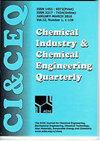低成本牛粪活性炭去除水溶液中呋喃的优化研究
IF 0.8
4区 工程技术
Q4 CHEMISTRY, APPLIED
Chemical Industry & Chemical Engineering Quarterly
Pub Date : 2021-01-01
DOI:10.2298/ciceq200427033h
引用次数: 4
摘要
由于工业化程度的提高,水污染已成为本世纪的一个严重问题。解决这一问题的方法有几种,其中包括活性炭吸附法。传统的活性炭制备方法既昂贵又不可再生。几种水果和农业废弃物具有成为活性炭制备可持续原料的特点。本研究旨在以可持续的牛粪为原料制备具有成本效益的空调。利用中心复合设计(CCD)对制备工艺进行了分析和优化。分析了活化温度、浸渍时间和浸渍比对产率R1和去除率R2的影响。采用R2、调整后的R2建立二次模型,预测R1的R2值分别为0.98、0.96、0.89,R2的R2值分别为0.97、0.94、0.87。活化温度和KOH/料比对产率和农药去除率有显著影响。优化后的活化温度为708.07℃,KOH/料比为1.22 h,活化时间为0.66 h。该条件产率为14.78%,农药去除率为89.18%。优化后的活性炭的SEM和BET分析也证实了活化过程导致的孔隙发育和大表面积可用性。本研究结果表明,牛粪可用于制备低成本的AC去除水溶液中的农药。本文章由计算机程序翻译,如有差异,请以英文原文为准。
Optimization of low-cost cow dung based activated carbon for the removal of carbofuran from aqueous solution
Water pollution has become a serious issue of this century due to increased industrialization. Several methods have been adopted to tackle this issue, including adsorption by activated carbon (AC). Conventional sources of AC preparation are costly and non-renewable as well. Several fruit and agricultural wastes have characteristics to become sustainable feedstock for AC preparation. This study aims to prepare cost effective AC from sustainable raw material, cow dung. The preparation has been analyzed and optimized by utilizing central composite design (CCD). The effect of activation temperature, time, and impregnation ratio (IR) on responses of percent yield ( R1) and percent pesticide removal (R2) has been analyzed. Quadratic models have been suggested with R2, adjusted R2, and predicted R2 values of 0.98, 0.96, 0.89 for R1, and 0.97, 0.94, 0.87 for R2, respectively. Activation temperature and KOH/Feedstock ratio significantly influence the yield and pesticide removal. Optimized conditions of activation temperature, KOH/Feedstock ratio, and activation time are 708.07 ?C, 1.22 and 0.66 h, respectively. These conditions produced 14.78% yield and 89.18% pesticide removal. SEM and BET analysis of optimized AC also confirmed porosity development and large surface area availability due to activation process. Findings of this study suggest that cow dung can be used to prepare low-cost AC for pesticide removal from aqueous solution.
求助全文
通过发布文献求助,成功后即可免费获取论文全文。
去求助
来源期刊

Chemical Industry & Chemical Engineering Quarterly
CHEMISTRY, APPLIED-ENGINEERING, CHEMICAL
CiteScore
2.10
自引率
0.00%
发文量
24
审稿时长
3.3 months
期刊介绍:
The Journal invites contributions to the following two main areas:
• Applied Chemistry dealing with the application of basic chemical sciences to industry
• Chemical Engineering dealing with the chemical and biochemical conversion of raw materials into different products as well as the design and operation of plants and equipment.
The Journal welcomes contributions focused on:
Chemical and Biochemical Engineering [...]
Process Systems Engineering[...]
Environmental Chemical and Process Engineering[...]
Materials Synthesis and Processing[...]
Food and Bioproducts Processing[...]
Process Technology[...]
 求助内容:
求助内容: 应助结果提醒方式:
应助结果提醒方式:


